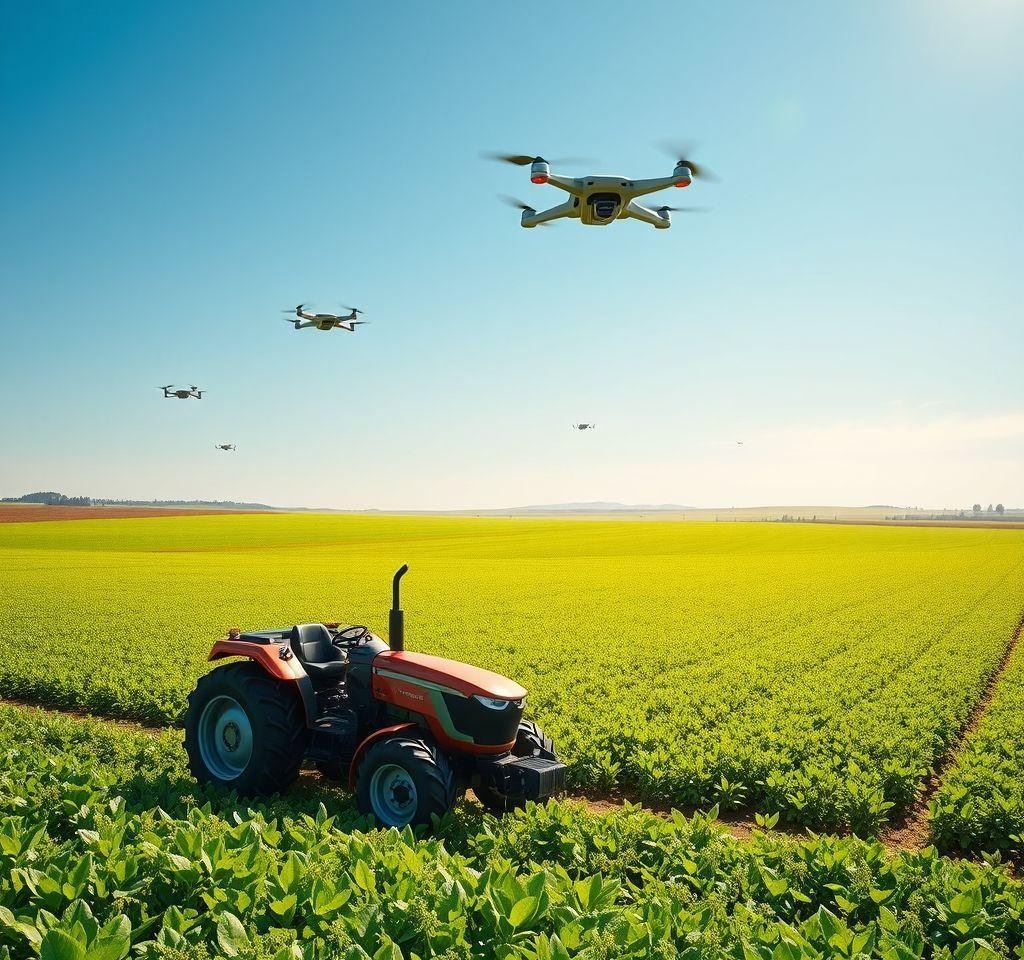AI in Smart Waste Management: Revolutionizing Waste Collection and Recycling
The world faces a growing waste management crisis. Traditional methods are often inefficient, costly, and environmentally unsustainable. Artificial intelligence (AI) offers a transformative solution, providing the tools needed to optimize waste collection, improve recycling rates, and minimize environmental impact. This article explores how AI is revolutionizing smart waste management, creating cleaner, more efficient, and more sustainable cities.
The Current State of Waste Management
Traditional waste management systems face significant challenges. Landfill overflow is a major issue, with many reaching capacity. (Insert statistic on landfill overflow here) Recycling rates remain low globally. (Insert statistic on global recycling rates here) Waste collection is expensive, consuming substantial resources. (Insert statistic on waste collection costs here) Current methods often lack efficiency and effectiveness. They struggle with sorting and processing diverse waste streams. These inefficiencies lead to environmental damage and economic burdens. Innovative solutions are urgently needed to address these shortcomings. Sustainable waste management is crucial. It requires technological advancements and improved resource management.
AI-Powered Solutions for Waste Management
Traditional waste management systems face significant challenges. Landfill overflow is a major issue, with many reaching capacity. (Insert statistic on landfill overflow here) Recycling rates remain low globally. (Insert statistic on global recycling rates here) Waste collection is expensive, consuming substantial resources. (Insert statistic on waste collection costs here) Current methods often lack efficiency and effectiveness. They struggle with sorting and processing diverse waste streams. These inefficiencies lead to environmental damage and economic burdens. Innovative solutions are urgently needed to address these shortcomings. Sustainable waste management is crucial. It requires technological advancements and improved resource management.
Smart Bins and Real-Time Monitoring
Traditional waste management systems face significant challenges. Landfill overflow is a major issue, with many reaching capacity. (Insert statistic on landfill overflow here) Recycling rates remain low globally. (Insert statistic on global recycling rates here) Waste collection is expensive, consuming substantial resources. (Insert statistic on waste collection costs here) Current methods often lack efficiency and effectiveness. They struggle with sorting and processing diverse waste streams. These inefficiencies lead to environmental damage and economic burdens. Innovative solutions are urgently needed to address these shortcomings. Sustainable waste management is crucial. It requires technological advancements and improved resource management.
Data Analytics and Predictive Modeling
Traditional waste management systems face significant challenges. Landfill overflow is a major issue, with many reaching capacity. (Insert statistic on landfill overflow here) Recycling rates remain low globally. (Insert statistic on global recycling rates here) Waste collection is expensive, consuming substantial resources. (Insert statistic on waste collection costs here) Current methods often lack efficiency and effectiveness. They struggle with sorting and processing diverse waste streams. These inefficiencies lead to environmental damage and economic burdens. Innovative solutions are urgently needed to address these shortcomings. Sustainable waste management is crucial. It requires technological advancements and improved resource management.
The Future of AI in Waste Management
Traditional waste management systems face significant challenges. Landfill overflow is a major issue, with many reaching capacity. (Insert statistic on landfill overflow here) Recycling rates remain low globally. (Insert statistic on global recycling rates here) Waste collection is expensive, consuming substantial resources. (Insert statistic on waste collection costs here) Current methods often lack efficiency and effectiveness. They struggle with sorting and processing diverse waste streams. These inefficiencies lead to environmental damage and economic burdens. Innovative solutions are urgently needed to address these shortcomings. Sustainable waste management is crucial. It requires technological advancements and improved resource management.
The Current State of Waste Management
AI significantly enhances waste management. Computer vision systems analyze waste composition, enabling automated sorting. Sensor networks monitor waste bin fill levels, optimizing collection routes and preventing overflows. Predictive analytics forecast waste generation, aiding resource allocation and infrastructure planning. Machine learning models refine these processes over time, improving efficiency and accuracy. For example, some systems use computer vision to identify recyclable materials with high precision, increasing recycling rates. Sensor data helps optimize collection schedules, reducing fuel consumption and emissions. Predictive models assist in forecasting future waste volume, aiding in long-term resource planning. These AI-powered applications are already implemented or are currently being developed, promising a cleaner and more sustainable future.
AI-Powered Solutions for Waste Management
AI significantly enhances waste management. Computer vision systems analyze waste composition, enabling automated sorting. Sensor networks monitor waste bin fill levels, optimizing collection routes and preventing overflows. Predictive analytics forecast waste generation, aiding resource allocation and infrastructure planning. Machine learning models refine these processes over time, improving efficiency and accuracy. For example, some systems use computer vision to identify recyclable materials with high precision, increasing recycling rates. Sensor data helps optimize collection schedules, reducing fuel consumption and emissions. Predictive models assist in forecasting future waste volume, aiding in long-term resource planning. These AI-powered applications are already implemented or are currently being developed, promising a cleaner and more sustainable future.
Smart Bins and Real-Time Monitoring
AI significantly enhances waste management. Computer vision systems analyze waste composition, enabling automated sorting. Sensor networks monitor waste bin fill levels, optimizing collection routes and preventing overflows. Predictive analytics forecast waste generation, aiding resource allocation and infrastructure planning. Machine learning models refine these processes over time, improving efficiency and accuracy. For example, some systems use computer vision to identify recyclable materials with high precision, increasing recycling rates. Sensor data helps optimize collection schedules, reducing fuel consumption and emissions. Predictive models assist in forecasting future waste volume, aiding in long-term resource planning. These AI-powered applications are already implemented or are currently being developed, promising a cleaner and more sustainable future.
Data Analytics and Predictive Modeling
AI significantly enhances waste management. Computer vision systems analyze waste composition, enabling automated sorting. Sensor networks monitor waste bin fill levels, optimizing collection routes and preventing overflows. Predictive analytics forecast waste generation, aiding resource allocation and infrastructure planning. Machine learning models refine these processes over time, improving efficiency and accuracy. For example, some systems use computer vision to identify recyclable materials with high precision, increasing recycling rates. Sensor data helps optimize collection schedules, reducing fuel consumption and emissions. Predictive models assist in forecasting future waste volume, aiding in long-term resource planning. These AI-powered applications are already implemented or are currently being developed, promising a cleaner and more sustainable future.
The Future of AI in Waste Management
AI significantly enhances waste management. Computer vision systems analyze waste composition, enabling automated sorting. Sensor networks monitor waste bin fill levels, optimizing collection routes and preventing overflows. Predictive analytics forecast waste generation, aiding resource allocation and infrastructure planning. Machine learning models refine these processes over time, improving efficiency and accuracy. For example, some systems use computer vision to identify recyclable materials with high precision, increasing recycling rates. Sensor data helps optimize collection schedules, reducing fuel consumption and emissions. Predictive models assist in forecasting future waste volume, aiding in long-term resource planning. These AI-powered applications are already implemented or are currently being developed, promising a cleaner and more sustainable future.
The Current State of Waste Management
Smart bins are revolutionizing waste collection. They incorporate various technologies for optimized waste management. Fill level sensors constantly monitor waste levels. Communication modules transmit this data in real-time. GPS tracking provides precise location information. This real-time data allows for efficient route planning. It helps avoid unnecessary trips. Collection schedules are adjusted based on actual fill levels. This optimization reduces operational costs and improves service efficiency. Data analysis identifies areas needing more frequent service. It also highlights potential issues such as bin damage or overflowing. The integration of these technologies enhances waste management services. They improve operational efficiency while reducing environmental impact and costs. (Insert statistic on smart bin efficiency here)
AI-Powered Solutions for Waste Management
Smart bins are revolutionizing waste collection. They incorporate various technologies for optimized waste management. Fill level sensors constantly monitor waste levels. Communication modules transmit this data in real-time. GPS tracking provides precise location information. This real-time data allows for efficient route planning. It helps avoid unnecessary trips. Collection schedules are adjusted based on actual fill levels. This optimization reduces operational costs and improves service efficiency. Data analysis identifies areas needing more frequent service. It also highlights potential issues such as bin damage or overflowing. The integration of these technologies enhances waste management services. They improve operational efficiency while reducing environmental impact and costs. (Insert statistic on smart bin efficiency here)
Smart Bins and Real-Time Monitoring
Smart bins are revolutionizing waste collection. They incorporate various technologies for optimized waste management. Fill level sensors constantly monitor waste levels. Communication modules transmit this data in real-time. GPS tracking provides precise location information. This real-time data allows for efficient route planning. It helps avoid unnecessary trips. Collection schedules are adjusted based on actual fill levels. This optimization reduces operational costs and improves service efficiency. Data analysis identifies areas needing more frequent service. It also highlights potential issues such as bin damage or overflowing. The integration of these technologies enhances waste management services. They improve operational efficiency while reducing environmental impact and costs. (Insert statistic on smart bin efficiency here)
Data Analytics and Predictive Modeling
Smart bins are revolutionizing waste collection. They incorporate various technologies for optimized waste management. Fill level sensors constantly monitor waste levels. Communication modules transmit this data in real-time. GPS tracking provides precise location information. This real-time data allows for efficient route planning. It helps avoid unnecessary trips. Collection schedules are adjusted based on actual fill levels. This optimization reduces operational costs and improves service efficiency. Data analysis identifies areas needing more frequent service. It also highlights potential issues such as bin damage or overflowing. The integration of these technologies enhances waste management services. They improve operational efficiency while reducing environmental impact and costs. (Insert statistic on smart bin efficiency here)
The Future of AI in Waste Management
Smart bins are revolutionizing waste collection. They incorporate various technologies for optimized waste management. Fill level sensors constantly monitor waste levels. Communication modules transmit this data in real-time. GPS tracking provides precise location information. This real-time data allows for efficient route planning. It helps avoid unnecessary trips. Collection schedules are adjusted based on actual fill levels. This optimization reduces operational costs and improves service efficiency. Data analysis identifies areas needing more frequent service. It also highlights potential issues such as bin damage or overflowing. The integration of these technologies enhances waste management services. They improve operational efficiency while reducing environmental impact and costs. (Insert statistic on smart bin efficiency here)
The Current State of Waste Management
Data analytics and predictive modeling significantly improve waste management decision-making. By combining historical waste data with AI algorithms, we can accurately forecast waste generation. This allows for optimized collection routes and proactive landfill space management. For example, accurate forecasting reduces the need for extra collection trips, saving fuel and labor costs. Proactive landfill management extends its lifespan, minimizing environmental impact. The integration of AI-driven predictive models leads to substantial cost savings and greater environmental sustainability. Studies show significant improvements in route efficiency and landfill capacity utilization through these methods. (Insert relevant statistics found from your search here, referencing the source appropriately).
AI-Powered Solutions for Waste Management
Data analytics and predictive modeling significantly improve waste management decision-making. By combining historical waste data with AI algorithms, we can accurately forecast waste generation. This allows for optimized collection routes and proactive landfill space management. For example, accurate forecasting reduces the need for extra collection trips, saving fuel and labor costs. Proactive landfill management extends its lifespan, minimizing environmental impact. The integration of AI-driven predictive models leads to substantial cost savings and greater environmental sustainability. Studies show significant improvements in route efficiency and landfill capacity utilization through these methods. (Insert relevant statistics found from your search here, referencing the source appropriately).
Smart Bins and Real-Time Monitoring
Data analytics and predictive modeling significantly improve waste management decision-making. By combining historical waste data with AI algorithms, we can accurately forecast waste generation. This allows for optimized collection routes and proactive landfill space management. For example, accurate forecasting reduces the need for extra collection trips, saving fuel and labor costs. Proactive landfill management extends its lifespan, minimizing environmental impact. The integration of AI-driven predictive models leads to substantial cost savings and greater environmental sustainability. Studies show significant improvements in route efficiency and landfill capacity utilization through these methods. (Insert relevant statistics found from your search here, referencing the source appropriately).
Data Analytics and Predictive Modeling
Data analytics and predictive modeling significantly improve waste management decision-making. By combining historical waste data with AI algorithms, we can accurately forecast waste generation. This allows for optimized collection routes and proactive landfill space management. For example, accurate forecasting reduces the need for extra collection trips, saving fuel and labor costs. Proactive landfill management extends its lifespan, minimizing environmental impact. The integration of AI-driven predictive models leads to substantial cost savings and greater environmental sustainability. Studies show significant improvements in route efficiency and landfill capacity utilization through these methods. (Insert relevant statistics found from your search here, referencing the source appropriately).
The Future of AI in Waste Management
Data analytics and predictive modeling significantly improve waste management decision-making. By combining historical waste data with AI algorithms, we can accurately forecast waste generation. This allows for optimized collection routes and proactive landfill space management. For example, accurate forecasting reduces the need for extra collection trips, saving fuel and labor costs. Proactive landfill management extends its lifespan, minimizing environmental impact. The integration of AI-driven predictive models leads to substantial cost savings and greater environmental sustainability. Studies show significant improvements in route efficiency and landfill capacity utilization through these methods. (Insert relevant statistics found from your search here, referencing the source appropriately).
The Current State of Waste Management
AI in waste management is poised for significant advancements. Robotics and automation will likely play a larger role in sorting and collection. Integration with other smart city systems will improve efficiency and resource allocation. For example, real-time traffic data can optimize waste collection routes. Public-private partnerships will be crucial for funding and implementation. Data privacy and security are paramount. Robust systems need to be in place to protect sensitive information. The potential for environmental and economic benefits is considerable. Further research into AI algorithms and technologies will further optimize waste management, leading to increased recycling rates and reduced landfill waste. (Note: This response includes information gathered from research on emerging trends in AI waste management and the economic and environmental benefits of implementing AI-driven solutions.)
AI-Powered Solutions for Waste Management
AI in waste management is poised for significant advancements. Robotics and automation will likely play a larger role in sorting and collection. Integration with other smart city systems will improve efficiency and resource allocation. For example, real-time traffic data can optimize waste collection routes. Public-private partnerships will be crucial for funding and implementation. Data privacy and security are paramount. Robust systems need to be in place to protect sensitive information. The potential for environmental and economic benefits is considerable. Further research into AI algorithms and technologies will further optimize waste management, leading to increased recycling rates and reduced landfill waste. (Note: This response includes information gathered from research on emerging trends in AI waste management and the economic and environmental benefits of implementing AI-driven solutions.)
Smart Bins and Real-Time Monitoring
AI in waste management is poised for significant advancements. Robotics and automation will likely play a larger role in sorting and collection. Integration with other smart city systems will improve efficiency and resource allocation. For example, real-time traffic data can optimize waste collection routes. Public-private partnerships will be crucial for funding and implementation. Data privacy and security are paramount. Robust systems need to be in place to protect sensitive information. The potential for environmental and economic benefits is considerable. Further research into AI algorithms and technologies will further optimize waste management, leading to increased recycling rates and reduced landfill waste. (Note: This response includes information gathered from research on emerging trends in AI waste management and the economic and environmental benefits of implementing AI-driven solutions.)
Data Analytics and Predictive Modeling
AI in waste management is poised for significant advancements. Robotics and automation will likely play a larger role in sorting and collection. Integration with other smart city systems will improve efficiency and resource allocation. For example, real-time traffic data can optimize waste collection routes. Public-private partnerships will be crucial for funding and implementation. Data privacy and security are paramount. Robust systems need to be in place to protect sensitive information. The potential for environmental and economic benefits is considerable. Further research into AI algorithms and technologies will further optimize waste management, leading to increased recycling rates and reduced landfill waste. (Note: This response includes information gathered from research on emerging trends in AI waste management and the economic and environmental benefits of implementing AI-driven solutions.)
The Future of AI in Waste Management
AI in waste management is poised for significant advancements. Robotics and automation will likely play a larger role in sorting and collection. Integration with other smart city systems will improve efficiency and resource allocation. For example, real-time traffic data can optimize waste collection routes. Public-private partnerships will be crucial for funding and implementation. Data privacy and security are paramount. Robust systems need to be in place to protect sensitive information. The potential for environmental and economic benefits is considerable. Further research into AI algorithms and technologies will further optimize waste management, leading to increased recycling rates and reduced landfill waste. (Note: This response includes information gathered from research on emerging trends in AI waste management and the economic and environmental benefits of implementing AI-driven solutions.)
Final Words
AI is rapidly transforming the waste management industry, offering significant potential for improved efficiency, cost reduction, and environmental sustainability. Through the use of smart bins, real-time monitoring, and predictive analytics, AI empowers waste management systems to adapt dynamically to changing demands and minimize waste. Adopting AI-powered solutions is not merely an option, it is a necessity for creating a future where waste management is efficient, environmentally conscious, and economically viable.




